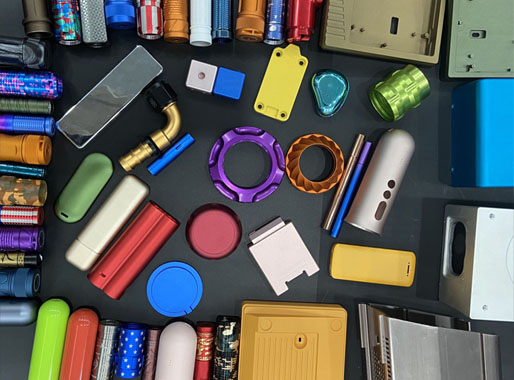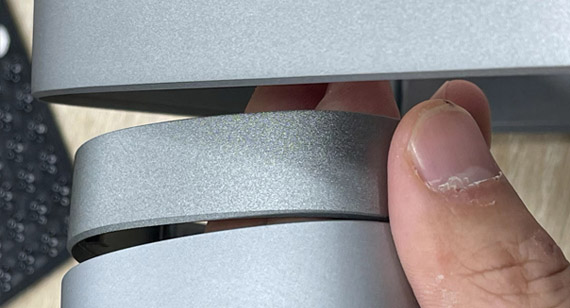15 years one-stop China custom CNC machining parts factory

Hey there I’m VMT Sam!
With 25 years of CNC machining experience we are committed to helping clients overcome 10000 complex part-processing challenges all to contribute to a better life through intelligent manufacturing. Contact us now
 208 |
Published by VMT at Mar 28 2024
208 |
Published by VMT at Mar 28 2024
Exploring the Number of Colors for Anodized Parts and Reasons for Color Variation Due to Long-Term Storage
In the realm of CNC machining for part manufacturing, anodizing is a common surface treatment method. It not only enhances the corrosion resistance and wear resistance of parts but also imparts specific colors and appearances to them. However, in practical production, issues regarding the number of colors for anodized parts and color variation after long-term storage often arise. This article aims to delve into these issues from a professional perspective and analyze the underlying reasons.

I. Determining the Number of Colors for Anodized Parts
The number of colors for anodized parts is not fixed and is influenced by various factors, including but not limited to anodizing process parameters, alloy composition, and surface condition. During CNC machining, different materials and process requirements may result in anodized parts displaying different colors. Therefore, determining the number of colors for anodized parts requires consideration of specific product requirements and processing conditions.
Typically, CNC machining factories establish anodizing process plans based on customer needs and product characteristics before production. These plans specify parameters such as temperature, time, and concentration to ensure that the color of anodized parts meets design requirements. Additionally, rigorous selection and control of raw materials are conducted to ensure their alloy composition and surface condition meet anodizing requirements.

II. Reasons for Color Variation in Anodized Parts Due to Long-Term Storage
Despite efforts to ensure color consistency during CNC machining, color variation may occur after long-term storage due to several reasons:
Stability of the Anodized Film: Anodizing forms a protective oxide layer on the surface of parts, and the color and stability of this layer directly affect the color of anodized parts. Over time, environmental factors such as temperature, humidity, and light exposure can degrade the stability of the anodized film, leading to color changes.
Differences in Storage Environments: Variances in storage environments can also impact the color of anodized parts. For instance, parts stored in humid environments are more susceptible to the effects of moisture and oxygen, altering the anodized film. Conversely, parts exposed to direct sunlight may experience color fading due to UV radiation.
Interaction between Anodized Film and Substrate: In certain cases, interactions between the anodized film and the substrate material may cause color changes. This interaction could result from the migration or diffusion of certain elements within the substrate material during the anodizing process, affecting the composition and structure of the anodized film.
III. Methods to Prevent and Control Color Variation in Anodized Parts
To address color variation in anodized parts resulting from long-term storage, the following measures can be implemented:
Optimizing Anodizing Processes: By optimizing anodizing process parameters, such as selecting appropriate anodizing agents and controlling temperature and duration, the stability and durability of the anodized film can be enhanced, reducing the likelihood of color changes over time.
Improving Storage Conditions: Providing a stable, dry storage environment for anodized parts and avoiding direct sunlight and high humidity can help preserve the color stability of the anodized film. Regular inspection and maintenance of storage facilities are also essential to ensure compliance with storage requirements.
Enhancing Quality Control: Strengthening quality control measures throughout the CNC machining process, from raw material selection to finished product inspection, helps identify and eliminate parts with potential color discrepancies. This ensures that only parts meeting color consistency requirements are delivered to customers.

IV. Conclusion
The determination of color variations in anodized parts and addressing color discrepancies resulting from long-term storage are crucial aspects of CNC machining part manufacturing. Through process optimization, environmental management, and quality control measures, it is possible to prevent and control color variations effectively, improving the quality and stability of anodized parts. CNC machining factories must continuously explore and adopt new technologies and methods to meet evolving market demands and product requirements.
This article aims to provide valuable insights and guidance for experts and professionals in the CNC machining part manufacturing field, contributing to the industry's ongoing development and innovation.
Ready To Start Your Next Project?
Get Instant Quote

Request a Free Quote
Send us a message if you have any questions or request a quote. We will get back to you ASAP!